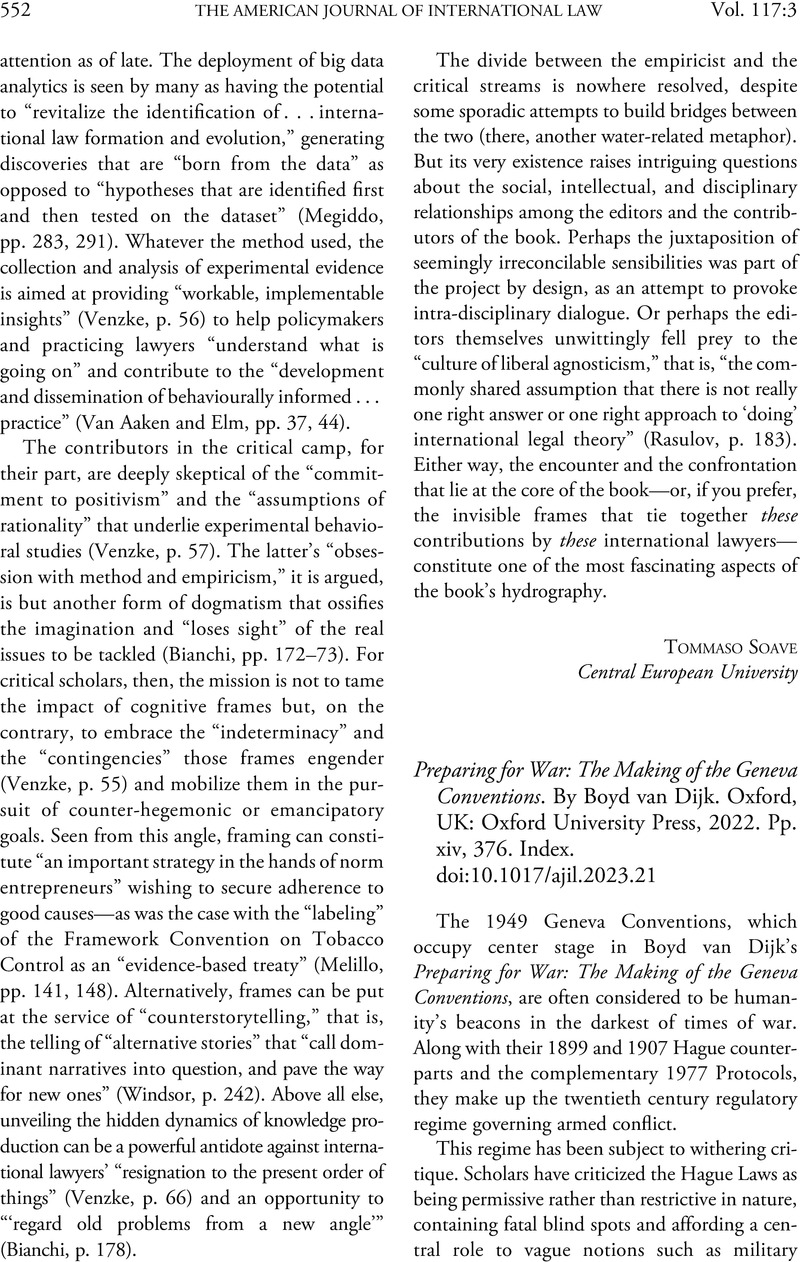No CrossRef data available.
Published online by Cambridge University Press: 27 July 2023

1 Jochnick, Chris af & Normand, Roger, The Legitimation of Violence: A Critical History of the Laws of War, 35 Harv. Int'l L.J. 49 (1994)Google Scholar.
2 Samuel Moyn, Humane: How the United States Abandoned Peace and Reinvented War (2021).
3 This image was used by William Schabas in relation to the Genocide Convention as he argued that the drafters of the Convention probably envisaged the erection of a monument commemorating the Holocaust, rather than conceiving a Convention they thought would apply to genocides yet to occur. W.A. Schabas, The Genocide Convention at Fifty, United States Institute of Peace Special Report (Jan. 7, 1999).
4 As more generally explored in: Contingency in International Law; On the Possibility of Different Legal Histories (Ingo Venzke & Kevin Jon Heller eds., 2021).
5 Katherine Fortin, Symposium on Boyd van Dijk's Preparing for War: Preparing for War – Demythologising the Post WWII Years and Charting the Untraveled Paths of CA3, Opinio Juris (Apr. 28, 2022).
6 With further references.
7 See, for instance, on internal French divisions between former resistance fighters and officials from the Ministry of Overseas Territories, the Ministry of War, and the Ministry of Foreign Affairs.
8 E.g., Giovanni Mantilla, Lawmaking Under Pressure; International Humanitarian Law and Internal Armed Conflict (2020).
9 The Netherlands only transferred sovereignty in 1949. Not being recognized by European powers, the young Indonesian Republic was not invited to Geneva as Van Dijk notes on page 21.
10 Dijk, Boyd van, Nederland en het oorlogsrecht; De normen van toen (The Netherlands and the Laws of War; the Norms of that Time), 14 De Groene (Apr. 6, 2022)Google Scholar; see also Dijk, Boyd van, Aggression, War Crimes, and the Indonesian Revolution, Verfassungsblog (Jan. 25, 2022)Google Scholar.
11 For more on the research program “Independence, Decolonization, Violence and War in Indonesia 1945–1950,” see here: https://www.ind45-50.org/en. The author of this review was a member of the Scientific Advisory Board. The research program has resulted in a series of books. The concluding findings are assembled in Gerd Oostindie et al., Beyond the Pale: Dutch Extreme Violence in the Indonesian War of Independence, 1945–1949 (2022).
12 Oostindie et al., supra note 11, at 30 (footnotes omitted).
13 See, e.g., Veraart, Wouter, Over de mogelijkheid van functioneel extreem geweld [About the Possibility of Functional Extreme Violence], 22 Nederlands Juristenblad 1771 (2022)Google Scholar.
14 Van Dijk, Aggression, War Crimes, and the Indonesian Revolution, supra note 10; Dijk, Boyd van, The Guardians; An International History of the Dutch and “Hague Law,” 1944–1949, in Shaping the International Relations of the Netherlands, 1815–2000; A Small Country on the Global Scene (Ruud van Dijk, Samuël Kruizinga, Vincent Kuitenbrouwer & Rimko van der Maar eds., 2018)CrossRefGoogle Scholar.
15 Letter to Parliament by Prime Minister Rutte Containing a Second Reaction of the Government on the Conclusions of the Research Programme Independence, Decolonization, Violence and War in Indonesia 1945–1950 (Dec. 14, 2022), available at www.rijksoverheid.nl.